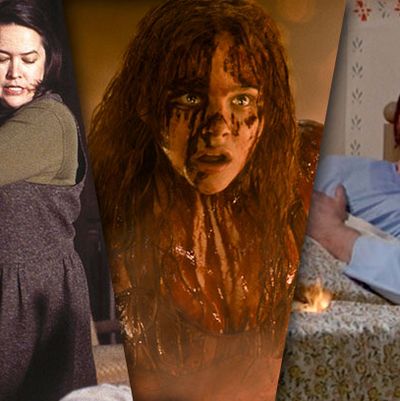
Almost 40 years after the publication of his first novel, Carrie, Stephen King remains a dominant force in American culture. No living American writer is as popular and few other writers produce work that lends itself so readily to film adaptations. King’s stories offer enticing high concepts that often brilliantly meld the irrationality of the classic horror tale with the small details of American middle-class existence. Yet there’s only been one good King movie for every three bad ones — Carrie, Cujo, The Dead Zone, The Shining, Misery, Dolores Claiborne, and Stand by Me on one side and Dreamcatcher, Hearts in Atlantis, Sleepwalkers, Maximum Overdrive, The Lawnmower Man, Needful Things, Thinner, Firestarter, The Dark Half, 1408, and almost all of the TV adaptations on the other. With this weekend’s remake of Carrie in mind, here are five tips for any screenwriter or filmmaker hoping to tackle the novelist’s rich, vast library.
1. Be Careful With the Dialogue
Though he wears it less ostentatiously, King’s as distinctive a stylist as Cormac McCarthy, and his characters often speak in a folksy campfire patois that’s simultaneously poetic and tone deaf. At their best, King’s characters converse in a fashion that allows the author to weave a rich cumulative tapestry of casual pop cultural references and revealing everyday details that evoke the texture of small-town life. At his sentimental worst, you wonder what planet his characters are meant to be from. But even at its best, King’s dialogue is usually too stylized to be spoken out loud, and actors often sound silly in their attempts to imbue it with tossed-off spontaneity, a problem that sinks the already problematic The Green Mile and nearly all of director Mick Garris’s adaptations. The best King movies, especially the original Carrie and The Dead Zone, invent new things for the characters to say that reflect and expand the intentions of the text. An exception to the rule: Screenwriter William Goldman wisely kept much of Annie Wilkes’s unnerving baby-talk in Misery, but she was supposed to sound off.
2. Wear Your Special Effects Lightly
This is a problem with American movies across the board, of course, as many stop dead in their narrative tracks in order to bombard the audience with elaborate CGI displays. The Stephen King adaptation is no exception, and a jarring, artless use of special effects compromises one of the King novel’s great pleasures: the author’s ability to dramatize with pinpoint precision that moment when a character’s life shifts from the reassuringly ordinary to the terrifyingly catastrophic. Once again, Carrie is the film to beat in conveying the unsettling violation of the supernatural’s ascension, because the special effects, as ancient as they may seem now, gracefully complement the story. Another bracing example of special effects done right in a King adaptation would be the underrated Cujo, which still contains some of the most convincingly understated animal stunt-work ever put onscreen. For lessons in what not to do, see the clunky, ugly, overly pyrotechnic Firestarter, Garris’s clumsy remake of The Shining, the needlessly bombastic 1408, and the recent Under the Dome, which managed to feel somehow simultaneously under- and over-produced.
3. Don’t Shortchange the Romance
So many of King’s stories are ultimately intense love stories, whether romantic or platonic. Carrie and Christine honored the various nesting love stories to be found in their respective source materials, releasing the despair and hopelessness that drove the author’s original revenge-of-the-nerd tales. Cujo regrettably pars some of the novel’s more personal subtext but compensates by refining and emphasizing the mother-son relationship that keeps us invested in the characters’ grueling struggle to survive, and Misery understands its source material as the tormented unrequited screwball romance it really is. For what not to do, see flat, impersonal spectacles like Pet Semetary (which ignores the book’s well-sketched marriage), Hearts in Atlantis (with its young boy/father figure relationship) and Dreamcatcher (about four old friends).
4. Maybe Try Something New?
Another universal Hollywood problem: Remake fever. This weekend’s Carrie, which is already being called an obvious, overly polished misstep that prompted this piece to begin with, is the fourth film to have been made from King’s book if you count The Rage: Carrie 2 and a 2002 TV movie version. Salem’s Lot and Pet Semetary have inspired three and two films apiece, respectively, and a new adaptation of IT is rumored to be in the works. Meanwhile, some of King’s most interesting books are either wasted in routine, literal-minded TV miniseries or ignored altogether. Bag of Bones is one of King’s best and most cinematic novels, but you wouldn’t know it from the lame 2011 TV film. And filmmakers seem to be largely blind to the recent decade of the writer’s career, which is rich in lively, resonant titles that could work like gangbusters on the screen: Duma Key, Lisey’s Story, and, perhaps the novelist’s crowning achievement of late, 11/22/63, which briefly had director Jonathan Demme attached.
5. Don’t Let Stephen King Adapt Your Stephen King Adaptation
King wrote the scripts for two of the very worst adaptations of his work: Pet Semetary, which is one of his best novels, and the TV remake of The Shining, which is so bad it discredited his famous and somewhat understandable dissatisfaction with the Stanley Kubrick version. As a screenwriter, King often artlessly cobbles together awkwardly undigested chunks of his novels with seemingly little thought as to how they might look and sound on the screen, and so we logically get stagey books-on-tape that fail to capture the lively essence of his work. And King tends to favor directors, such as Mick Garris and Frank Darabont, who value fealty to his material but have rarely made films that are actually good. Kubrick changed The Shining, and his film is problematic, but it’s also a troubling pop-cultural totem that continues to resonate with tension and mystery, while I doubt many audiences even remember that the Garris version exists at all.

